Italian Easter Bread – a soft and sweet braided bread tucked with colorful hardboiled eggs and baked to golden perfection. This popular Easter homemade bread tastes so rich, buttery, and so divine you won’t resist. And it comes in two versions! Definitely a must-have in every Easter get-together.
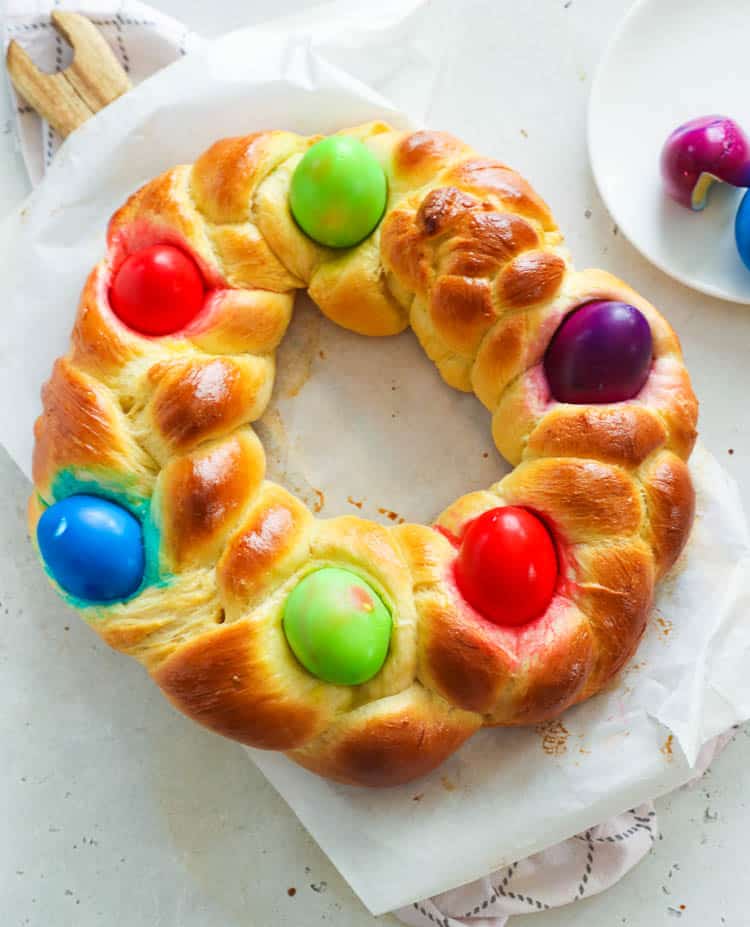
Traditional Must-Have A lot of family traditions are associated with Easter, whether it’s a family lunch out, a neighbor cookout, or just a simple family gathering. It brings out people together to celebrate. And this Easter bread is a must-have!
A pretty braided bread that is so fluffy with just the right amount of sweetness! I wouldn’t mind eating this all day especially when it’s warm, smothered with butter and jam. Aaaah! So yummy!😍
The ones with sugar glaze and sprinkles are reserved for my dessert, of course. My son and I would eat it with ice cream.
You should try it! I can’t wait to eat them again! The addition of vibrant and colorful eggs makes it even more fabulously Easterrrific!😉
What is Easter Bread?
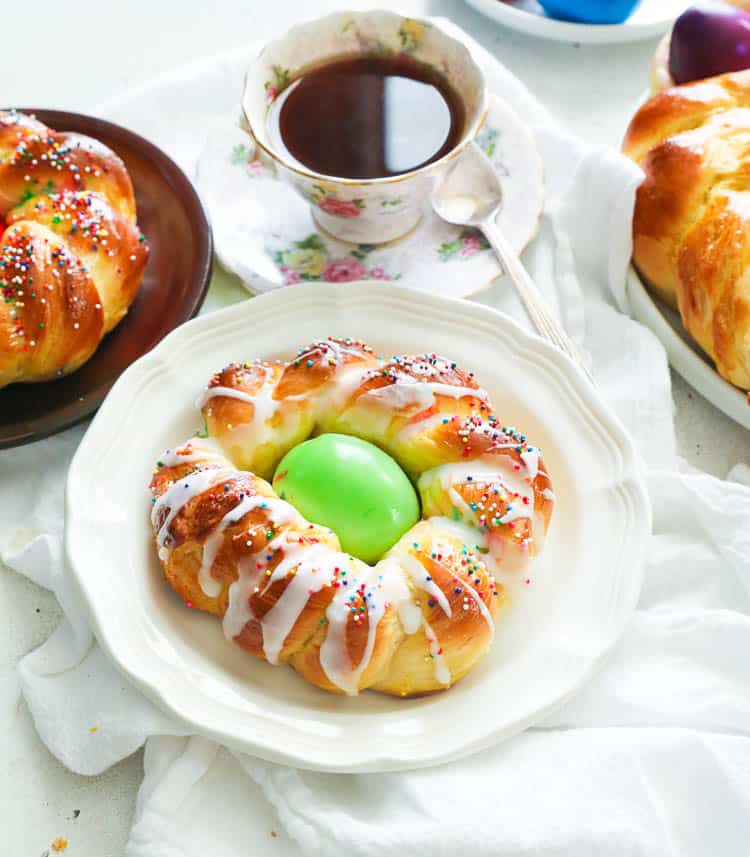
Easter Bread, with known Italian and Greek origin, is not only meant to be eaten, but also to convey a symbolic meaning known to Christians. Traditions are passed on to different generations.
- The bread itself represents Jesus being the Bread of Life.
- The Easter Bread wreath is the crown of thorns worn by Jesus while the three-dough rope braids signify the Holy Trinity.
- As for the eggs, they symbolize rebirth or the resurrection of Jesus.
I would like to think that the wreath shows God’s unending love rather than being compared to the crown of thorns. Well, it’s just me. Anyway, what important is that whatever religion we have, we still get to enjoy this yummy Easter Egg Bread.
Recipe Ingredients and Substitutions
Yeast has a vital role in this recipe. It makes this sweet bread nice and soft and so satisfying to eat. Other than that, we also need the following to make this bread recipe:
Bread Dough:
- Water – Adding it in the flour to liquefy and gives moisture to make the dough.
- Active Yeast – While raising up the dough, it also gives a yeasty aroma, and makes the bread soft.
- Unsalted Butter – To give your buns the perfect moisture; we use it to add a richer taste.
- Granulated Sugar – Common table sugar you can easily find in any grocery store.
- Salt – A basic ingredient that intensifies all other flavors.
- Large Eggs – Helps up in the rising process adds to makes the dough’s texture airy.
- All-purpose Flour – This pantry must-have isn’t just for baking. it’s also great for many savory dishes.
Dyed Eggs:
- Hard-boiled Eggs – In this Easter bread recipe, we will using colorful hard-boiled eggs to make it EGGS-citing!
- Vinegar – When you add vinegar to the water, it creates ideal conditions for food coloring to dye the egg.
- Food Coloring – and of course, we will use food coloring to make the eggs colorful!
Substitutions for Dyes
Did you know that you can make natural dyes using ordinary pantry staples like vegetables, condiments, and spices? So if you are not a fan of food coloring, I got you!
Go to your kitchen and see if you already have the following and let’s get started.
Boiled Version
Boil Prep – In a saucepan, boil 2 cups of water and add any of the following ingredients:
- Yellow – ½ tablespoon turmeric powder + ½ tablespoon vinegar
- Red-Orange – 4 tablespoons Paprika + 4 teaspoons vinegar
- Jade Green – peeled skin from 6pcs red onion + 3 teaspoon vinegar and simmer for 15 minutes
- Note: Rest and let it cool to room temperature before transferring to a glass container.
No-Boiling/Cooking Version
- Brown – 1 cup strong coffee + 1 tablespoon vinegar
- Lavender – 1 cup grape juice (no need to boil) + 1 tablespoon vinegar
NOTE: Remember to clean the eggs thoroughly before soaking them in newly made dyes, covered. Refrigerate overnight for more vibrant color results.
You can also try experimenting with other fruits, veggies, and spices like carrots, dill seeds, annatto seeds, apple, blueberries, etc. And you can also be playful by mixing different colors and you’ll be amazed at the results.
Do You Need to Cook the Eggs Before Baking?
I prefer boiling the eggs first before putting them into my braided Easter bread. Simply because my son loves to dye those eggs and you know how kids are… yeah!
So, you know what happens next if we use raw eggs… cracked eggs, messy floors, and table counters. Yikes!😬
Anyway, if you prefer soft boiled eggs, you can opt to bake this with raw eggs, especially if you love dipping your bread into a soupy hot egg yolk. Since baking time is long enough to cook the egg, it is STILL SAFE TO EAT even if the yolks came out a little runny.
Decorating the Bread
Easter Bread Wreath is the most commonly used design because of its symbolic aspect. Next is the classic bread with an egg in the middle which is meant for sharing with others or giving them as a gift.
There are different versions of this bread recipe.
- It can be in different forms, with or without eggs tucked in the bread.
- Some make it more festive by putting candy sprinkles on top or different kinds of nuts like sliced almonds or crushed pecan (or go with my Candied Pecans HERE).
- Others topped them with sesame seeds or poppy seeds (or use my Homemade Everything Bagel Seasoning HERE) for those who like it simple.
- You can also use sugar glaze for that glossy effect or pour chocolate ganache on top if you have a sweet tooth like me.
A lot of creative bakers now innovate with bread designs, incorporating nature and animal shapes. My favorite ones are those that look like flowers. They are just too adorable and elegant looking.😍
Storage and Make-Ahead Instructions
Storing
Store your Easter Egg Bread in an airtight container or wrap it in foil or cling wrap. It can stay fresh:
- Room Temperature – for up to 5 days
- Refrigerated – it can last up to 10 days
- Freezer – can last up to 2 months
NOTE: Just be sure to consume the eggs first before storing them.
Making the Dough Ahead
You can also prepare the dough a day before. After you braid the bread, place it in a baking pan covered with greased plastic wrap or cling wrap. Refrigerate overnight.
When ready to bake…
- Take it out from the fridge.
- Let it sit on the counter for 60 minutes, still covered.
- Proceed to bake it according to the instructions below. You can also dye your eggs at this time. Soaking them overnight makes the color more vibrant.
Other Bread Recipes You’ll Love
My day won’t be complete if I didn’t get to eat bread. Okay, don’t judge me! I just love bread sooo much. That’s why I’m sharing with you below some of my favorite bread recipes that you can try at home.
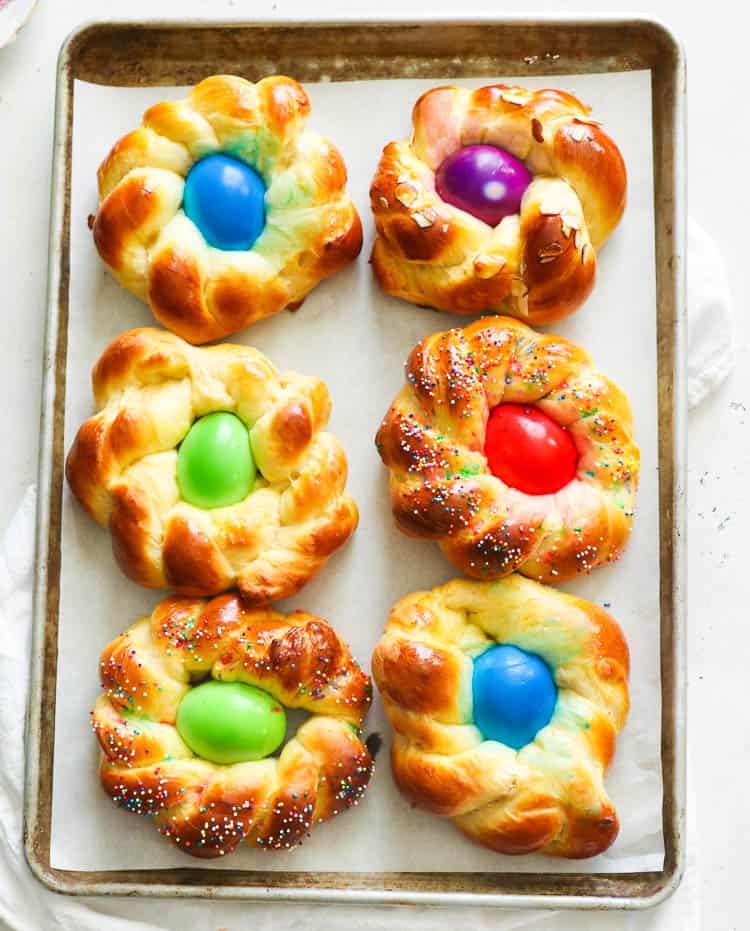
How To Make Easter Bread
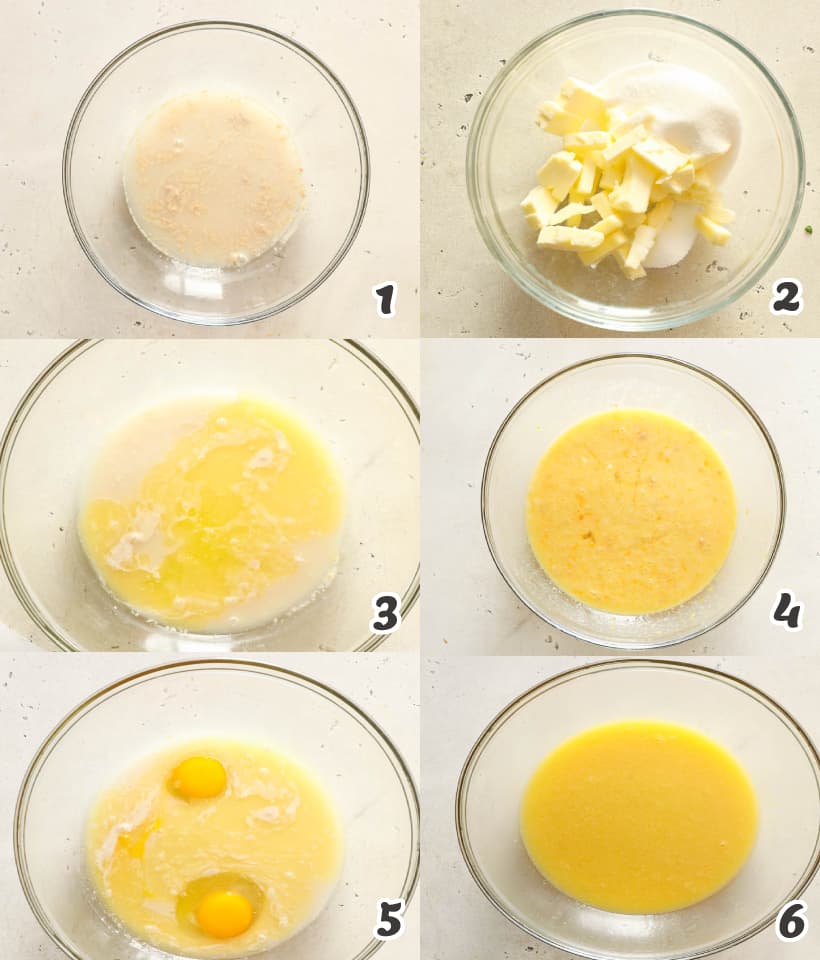
Proof the Yeast
- Combine Lukewarm Water and Yeast – Let it sit until it dissolves for about 5 minutes. ( Photo 1) You may do so in a standing mixer if using one.
- Combine Leftover Ingredients – Meanwhile, in a microwave-safe medium bowl, add butter chunks, sugar, salt, and microwave for about a minute. (Photo 2)
- Stir – Stir until everything is melted – the mixture should be warm, not hot. Let it cool slightly if the mixture is hot. (Photo 3-4)
- Dump Everything into the Yeast Mixture – Whisk the egg into the mixture. (Photo 5) If the mixture is too hot let it cool to a warm mixture to prevent eggs from curdling. Mix until ingredients are fully combined. (Photo 6)

Knead the Dough
- Combine Flour and Yeast Mixture. – Add about 3 cups of flour (Photo 7) and continue mixing by hand or using a paddle. Add in enough additional flour (if needed) to make a soft dough. (Photo 8)
- Knead the Dough until Smooth and Elastic – Turn the dough on a lightly floured surface (Photo 9) and knead for 6-7 minutes (Photo 10) or until the dough becomes smooth and elastic. (Photo 11)
- Form a Ball and Let it Rise – Transfer the dough to a greased bowl and cover with a damped cloth. Leave it for 2 hours or until doubled in size. You can make the dyed eggs while the bread is rising. (Photo 12)
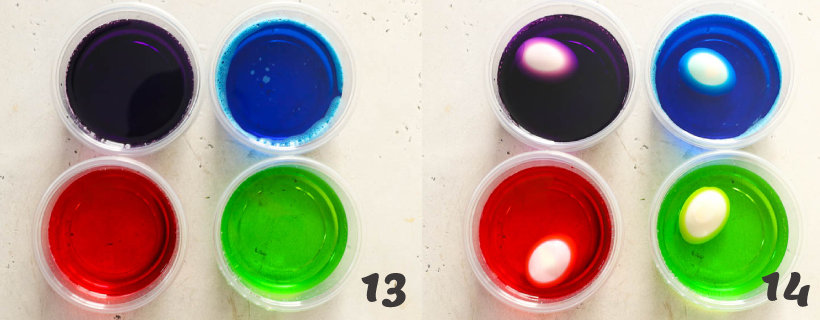
Dye the Eggs
- Portion the Water – Add 4 cups of water to a saucepan and bring to a bowl. Pour ½ cup of water in 4 or more bowls, depending on individual color preference.
- Add Vinegar and Food Color – In each bowl, stir in 1 teaspoon vinegar and 10 to 20 drops of food color – it depends on the desired colors. Do the same for all the bowls. (Photo 13-14)
- Soak the Eggs in Dye – Carefully place eggs in a bowl using a spoon and let it sit for about 5 minutes. After 5 minutes have elapsed, remove with a slotted spoon and place on a cookie rack to dry up. Use as needed. Use a slotted spoon, wire egg holder, or tongs to add and remove eggs from the dye. Allow eggs to dry.
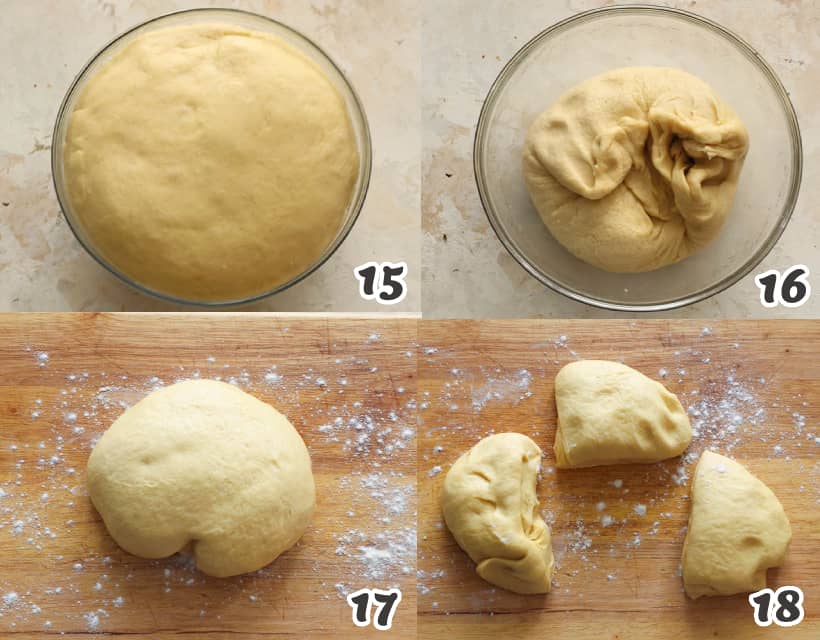
Divide the Dough
- The Dough has Doubled in Size – Once the dough has doubled (Photo 15), punch the dough (Photo 16) and turn it out onto a lightly floured surface and carefully knead to remove air pockets. (Photo 17)
- Divide the Dough – Follow instructions and divide the dough for either individual or Easter bread. (Photo 18)
Easter Bread
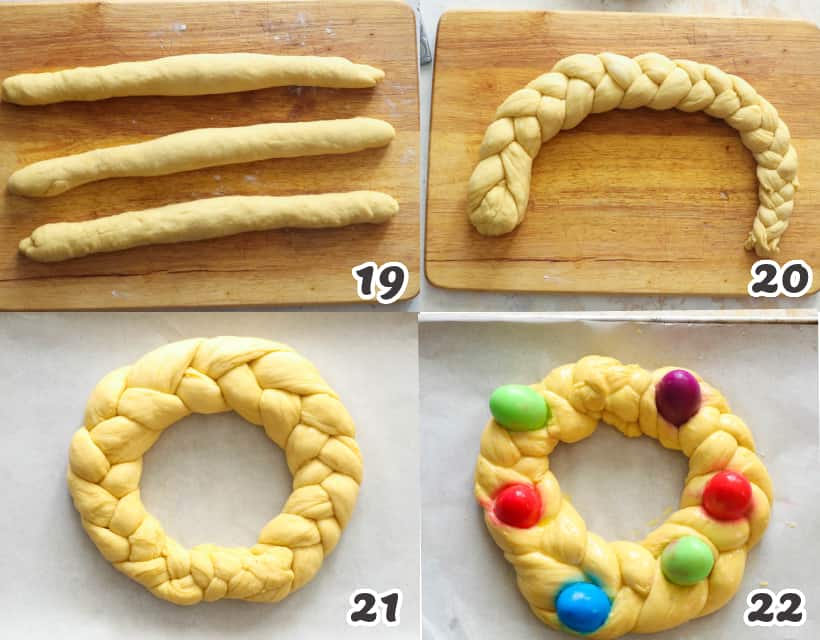
Brading and Shaping the Dough
- Stretch/Roll the Dough – Stretch or roll out the dough into an even thickness of about approximately 16-inch-long rope with tapered ends. (Photo 19) Braid the strands loosely; so you can easily tuck the eggs in the pocket. (Photo 20)
- Braid the Dough – Take the left strand and cross it over the middle strand. Take the right strand and cross it over the middle strand, until bread is completed. (Photo 20) Tightly pinch to seal the end. Shape the dough into a ring (Photo 21) and gently seal the ends of the ring together. Tuck the eggs. (Photo 22) Loosely cover with plastic wrap or a kitchen towel. Let it rise in a warm, draft-free area until puffed about 20 –30 minutes.
- Prep the Oven and Dough – Preheat oven to 350 degrees F (177 degrees C). Gently brush the dough with the beaten egg wash, being careful around dyed eggs and not deflate the dough. Sprinkle with sprinkles, if desired.
- Bake and Apply the Icing – Bake in a preheated oven for about 30 to 40 minutes, or until the bread is golden brown. If it browns quickly, cover it loosely with foil paper. Remove, let it cool before applying it with icing.
Individual Easter Bread
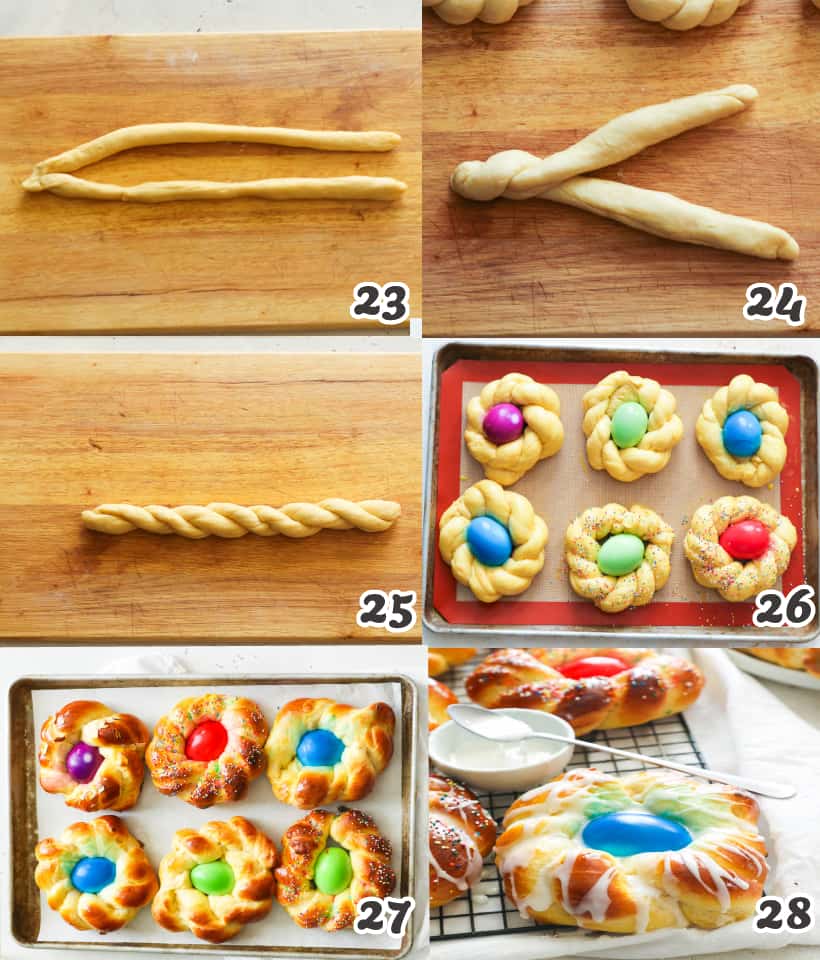
Baking and Decorating
- Twist the Dough – For single bread, divide each dough into 6-7 pieces equal pieces. Take each piece and divide it in half. Then stretch each strand into 14-15 inch inches long. (Photo 23) Pinch the two strands together and twist together. (Photo 24-25) Bring together to form a circle. (Photo 26) Make sure there is just pocket space in the middle to tuck the eggs. Pinch the ends. Repeat with the remaining dough, until all the pieces have been used up. (Photo 23-26)
- Tuck the Eggs – Line a cookie sheet pan with parchment paper and then transfer the dough onto the pan. Tuck with Easter eggs. (Photo 26) Loosely cover with plastic wrap or a kitchen towel. Let them rise in a warm, draft-free area until puffed about 20–30 minutes.
- Prep the Oven and the Dough – Preheat oven to 350 degrees F (177 degrees C). Gently brush the dough with the beaten egg wash, being careful around dyed eggs and not to deflate the dough. Sprinkle with sprinkles, if desired. In a preheated oven, bake the dough for about 25 to 30 minutes, or until the bread is golden brown.
- Bake and Apply the Icing -If it browns quickly, cover it loosely with foil paper. Remove, let it cool before applying it with icing.
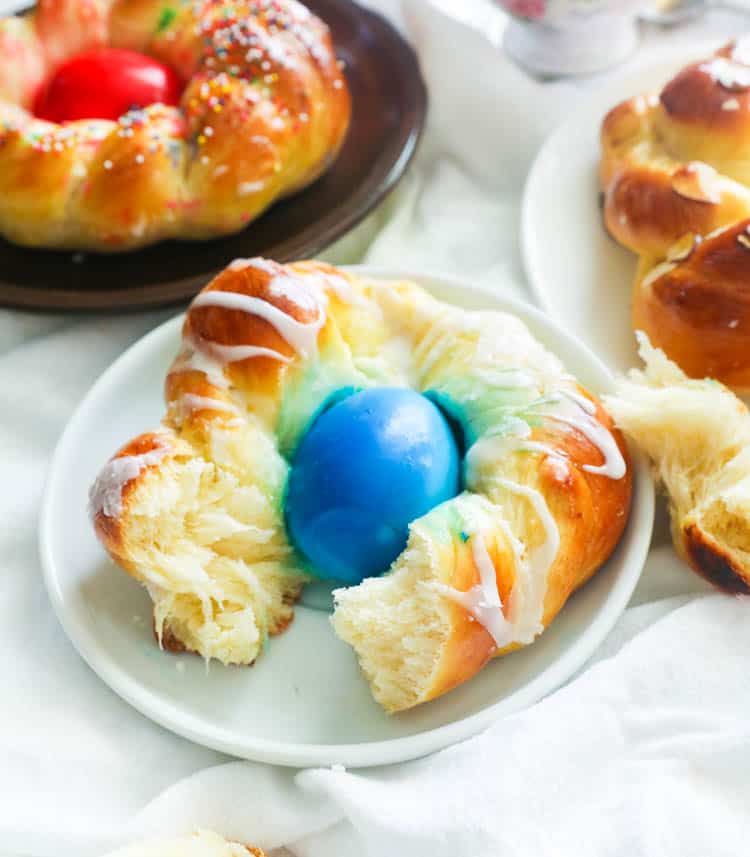
Watch How To Make It
[adthrive-in-post-video-player video-id=”8bhlgOyO” upload-date=”2021-03-26T07:00:00.000Z” name=”Easter Bread” description=”Italian Easter Bread – Soft and sweet braided bread tucked with colorful hardboiled eggs and baked to golden perfection. This popular Easter homemade bread tastes so rich, buttery, and so divine you won’t resist. And it comes in two versions! Definitely a must-have in every Easter get-together. ” player-type=”collapse” override-embed=”false”]
Italian Easter Bread
Ingredients
- ¾ cup (177 ml) water at room temperature
- 1 envelope (about 2 1/4 teaspoons) active yeast
- 5 tablespoons (70 g) unsalted butter, cut into chunks
- ¼ cup (50 g) granulated sugar
- 1 ¼ teaspoons (6 g) salt
- 4 large eggs
- 3 ¼ - 3 ½ cups (406 g) all-purpose flour, plus more for dusting
Dyed Eggs
- 4 cups water
- 5-7 large boiled eggs
- 5-7 teaspoons white vinegar
- food coloring
Egg Wash (Brushing the Top)
- 1 large egg
- 2-3 tablespoons milk or cream
Optional Topping
- sprinkles or sliced almond
Glaze (optional)
- 1 cup confectioners' sugar
- 1 teaspoon vanilla extract
- 2-3 tablespoons milk, adjust to desired thickness
Instructions
- Combine lukewarm water and yeast. Let it sit until it dissolves for about 5 minutes. You may do so in a standing mixer if using one.
- Meanwhile, in a microwave-safe medium bowl, add butter chunks, sugar, salt, and microwave for about a minute.
- Stir until everything is melted - the mixture should be warm, not hot. Let it cool slightly if the mixture is hot. Dump everything into the yeast mixture.
- Whisk the egg into the mixture. If the mixture is too hot let it cool to a warm mixture to prevent eggs from curdling. Mix until ingredients are fully combined.
- Add about 3 cups of flour and continue mixing by hand or using a paddle dough. Add in enough additional flour (if needed) to make a soft dough.
- Turn the dough on a lightly floured surface and knead for 6-7 minutes or until the dough becomes smooth and elastic. Form a ball.
- Transfer the dough to a greased bowl and cover with a damped cloth. Leave it for 2 hours or until doubled in size. You can make the dyed eggs while the bread is rising.
How to Dye Easter Eggs
- Add 4 cups of water to a saucepan and bring to a bowl.
- Pour ½ cup of water in 4 or more bowls, depending on individual color preference.
- In each bowl, stir in 1 teaspoon vinegar and 10 to 20 drops of food color - it depends on the desired colors. Do the same for all the bowls.
- Carefully place eggs in a bowl using a spoon and let it sit for about 5 minutes. After 5 minutes have elapsed, remove with a slotted spoon and place on a cookie rack to dry up. Use as needed.
- Use a slotted spoon, wire egg holder, or tongs to add and remove eggs from the dye. Allow eggs to dry.
- Once the dough has doubled, turn it out onto a lightly floured surface and follow instructions for either individual or Easter bread.
Easter Bread
- Stretch or roll out the dough into an even thickness of about approximately 16-inch-long rope with tapered ends.
- Braid the strands loosely; so you can easily tuck the eggs in the pocket. Take the left strand and cross it over the middle strand. Take the right strand and cross it over the middle strand, until bread is completed. Tightly pinch to seal the end.
- Shape the dough into a ring and gently seal the ends of the ring together. Tuck the eggs. Loosely cover with plastic wrap or a kitchen towel. Let it rise in a warm, draft-free area until puffed about 20 –30 minutes.
- Preheat oven to 350 degrees F (177 degrees C). Gently brush the dough with the beaten egg wash, being careful around dyed eggs and not deflate the dough. Sprinkle with sprinkles, if desired.
- Bake in a preheated oven for about 30 to 40 minutes, or until the bread is golden brown. If it browns quickly, cover it loosely with foil paper.
- Remove, let it cool before applying it with icing.
Individual Easter Bread
- For single bread, divide each dough into 6-7 pieces equal pieces. Take each piece and divide in half. Then stretch each strand into 14-15 inch inches long. Pinch the two strands together and twist together.
- Bring together to form a circle. Make sure there is just pocket space in the middle to tuck the eggs. Pinch the ends. Repeat with the remaining dough, until all the pieces have been used up.
- Line a cookie sheet pan with parchment paper and then transfer the dough onto the pan. Tuck with Easter eggs.
- Loosely cover with plastic wrap or a kitchen towel. Let them rise in a warm, draft-free area until puffed about 20–30 minutes.
- Preheat oven to 350 degrees F (177 degrees C)
- Gently brush the dough with the beaten egg wash, being careful around dyed eggs and not to deflate the dough. Sprinkle with sprinkles, if desired.
- In a preheated oven, bake the dough for about 25 to 30 minutes, or until the bread is golden brown. If it browns quickly, cover it loosely with foil paper.
- Remove, let it cool before applying it with icing.
Bread Icing
- Whisk the confectioners' sugar, vanilla extract, and milk, adding a few drops more of milk, as needed to make the glaze smooth and pourable.
- Drizzle as much as you like over the bread with a fork or spoon. Serve with a cup of tea.
Tips & Notes:
- Natural Dyes Using Spices. In a saucepan, boil 2 cups of water and add: ½ tbsp turmeric powder + ½ tbsp vinegar, for yellow; 4 tbsp Paprika + 4tsp vinegar for red-orange AND peeled skin from 6pcs red onion + 3 tsp vinegar. Simmer for 15 minutes to achieve jade green color. Rest and let it cool to room temperature before transferring to a glass container.
- No Boiling/Cooking Natural Dye. Simply mix 1 cup strong coffee + 1 tbsp vinegar, for brown AND nd 1 cup grape juice (no need to boil) + 1 tbsp vinegar, for lavender.
- You may boil the eggs first before tucking them into the bread OR bake the bread with raw eggs if you prefer soft-boiled eggs. The baking time is long enough to cook the eggs.
- Go creative when it comes to your toppings. You can decorate your bread with candy sprinkles, sliced nuts, sesame seeds, poppy seeds, or my Homemade Everything Bagel Seasoning HERE. You can also use sugar glaze for that glossy effect or pour chocolate ganache on top.
- You can also prepare the dough a day before. After you braid the bread, place it in a baking pan covered with greased plastic wrap or cling wrap. Refrigerate overnight.
- Nutritional information is provided as a courtesy only. Please keep in mind that it is a rough estimate rather than a guarantee. Ingredients can vary greatly based on the products used.
Nutrition Information:
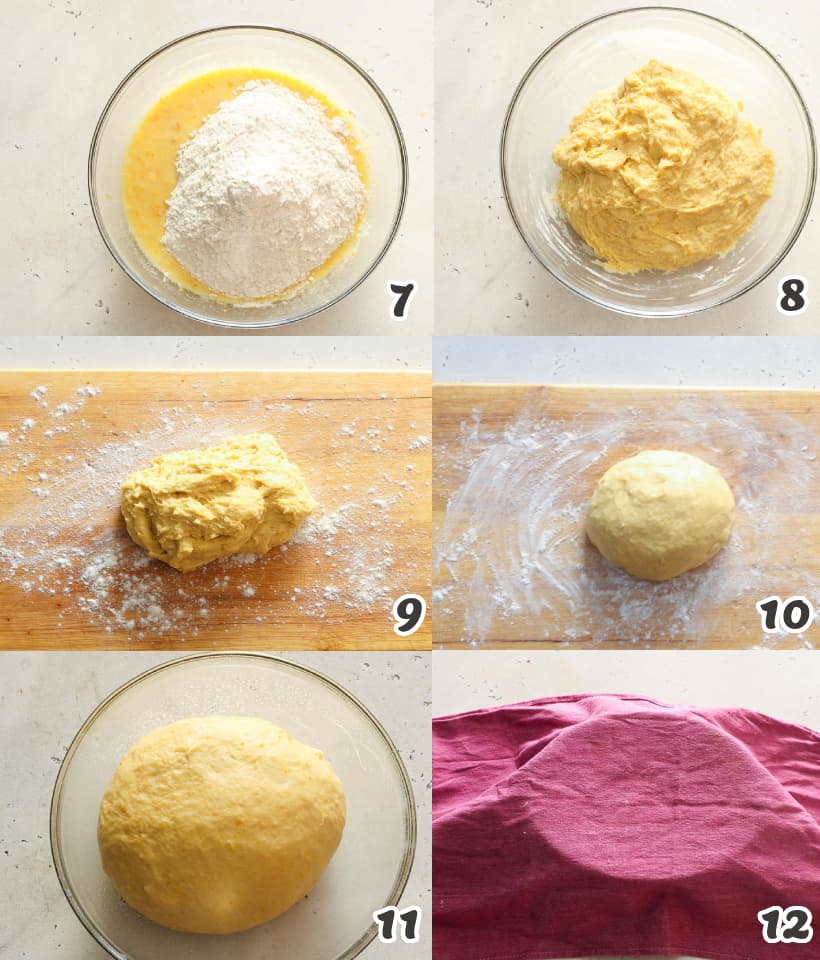
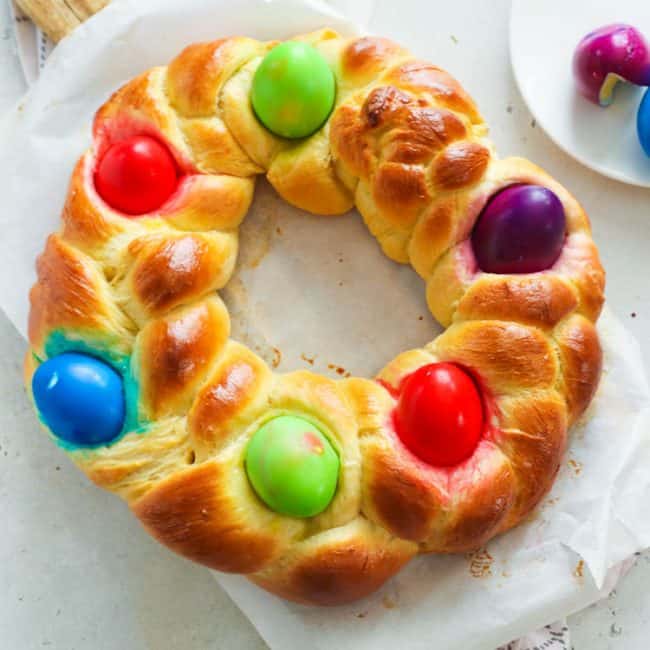

Leave a Review